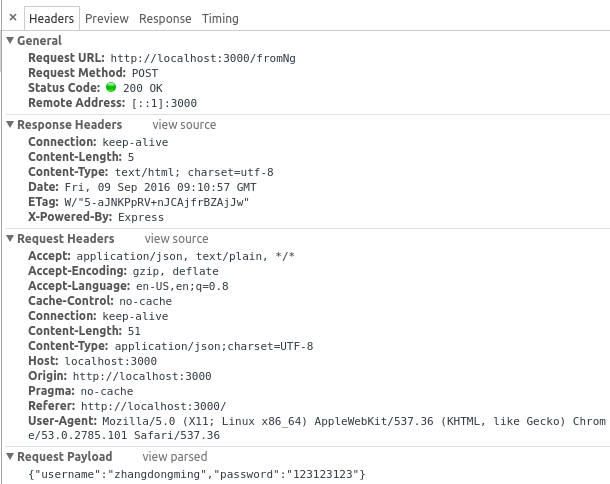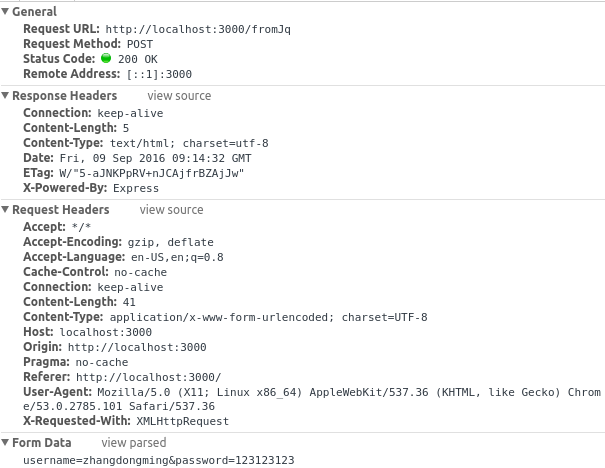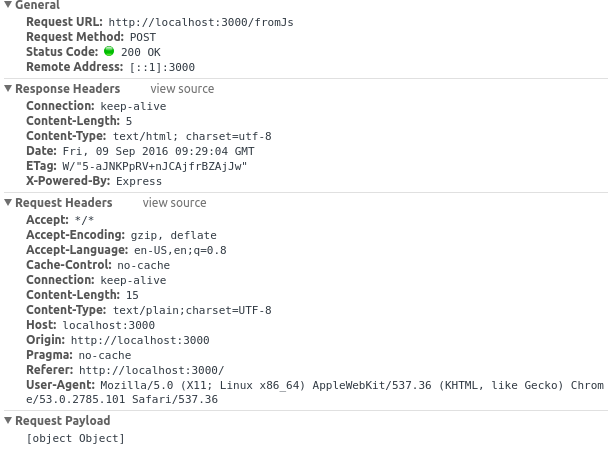这也是最近遇到的坑,还是之前那个项目,现在要实现登录功能。
背景:注册功能之前已经跑通了。前端用的是jquery后台是springMVC。鉴于注册和登录有些接口功能是类似的(比如注册确保邮箱是没有注册过,而登录是确保注册过),于是后台还准备用注册的那套接口。
登录的接口get请求是没问题的,但是post却出了问题:后台收不到请求体里的内容。
后来发现是jquery和angular的post行为有些区别,于是我做了个实验。
<!DOCTYPE html>
<html lang="en" ng-app="app">
<head>
<meta charset="UTF-8">
<title>Title</title>
</head>
<body ng-controller="body">
<button id="ng-btn" ng-click="sendNgPost()">ng-btn</button>
<button id="jq-btn">jq-btn</button>
<button id="js-btn">js-btn</button>
</body>
<script src="bower_components/jquery/dist/jquery.js"></script>
<script src="bower_components/angular/angular.js"></script>
<script>
angular.module('app',[]).controller('body',function ($scope,$http) {
var data={username:'zhangdongming',password:'123123123'};
$scope.sendNgPost=function () {
$http({
method:'POST',
url:'/fromNg',
data:data
}).then(function (res) {
console.log(res);
})
};
$('#jq-btn').click(function () {
$.post('/fromJq',data,function (data) {
console.log(data);
})
});
function post(sendData) {
var xhr=new XMLHttpRequest();
xhr.open('post','/fromJs',true);
xhr.onload=function () {
console.log(xhr.responseText);
};
xhr.send(data);
}
var btn=document.querySelector('#js-btn');
btn.onclick=function () {
post(data);
}
});
</script>
</html>
这段代码的作用就是用angularjs,jquery和js发post请求
服务端是express写的
var express=require("express"); var mime = require('mime'); var http = require('http'); var util = require('util'); var url = require('url'); var fs = require('fs'); var path=require('path'); var formidable=require('formidable'); var querystring = require('querystring'); var bodyParser=require("body-parser"); app=express(); // var data=[ // {screenName:"zhangdongming",phoneNumber:"15210938964",email:"fortunewheel@sina.com"} // ]; app.use(express.static(path.join(__dirname))); app.use(bodyParser.json()); app.use(bodyParser.urlencoded({extended:false})); app.get('/',function (req,res) { res.sendfile(path.resolve("client.html")); }); app.post('/fromNg',function (req,res) { console.log(req.body); res.send('false'); }); app.post('/fromJq',function (req,res) { console.log(req.body); res.send('false'); }); app.post('/fromJs',function (req,res) { console.log(req.body); res.send('false'); }); app.listen(3000);
注意,body-parser中间件use我写了两句。
好了现在看看这三个请求是什么样子的。
这个是angular的

用jquery

用js

注意看Content-Type ng是appliction/json,jq是application/x-www-form-urlencoded,js是text/plain。
而Request Payload中,ng是json字符串,jq经过了序列化,js是个???
对于express的body-parse中间件来说,两种格式的都可以,只需要写好对应的use就可以了。
而我们后台的接口写法只能接收urlencoded格式的,json是收不到的。
这种事情自然是前端想办法,很简单,都转成jquery的格式就行了。
具体来讲,对于js来讲,加上两句:
1.换格式config(function ($httpProvider) {
$httpProvider.defaults.headers.post['Content-Type'] = 'application/x-www-form-urlencoded;charset=utf-8';
})
2.序列化工作就比较简单了,因为用angular一般会默认带上jqeruy,$.param()可以方便的完成这项工作
$http({
method: 'POST',
url: '/fromNg',
data: $.param(data)
}).then(function (res) {
console.log(res);
})
以上。